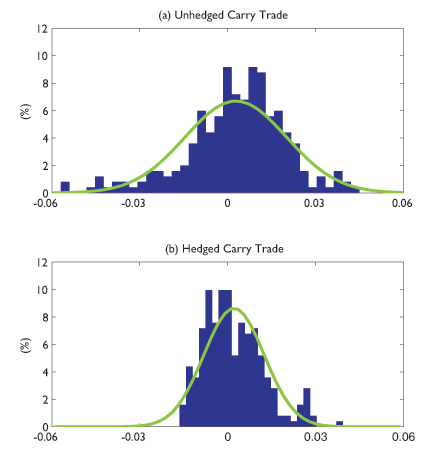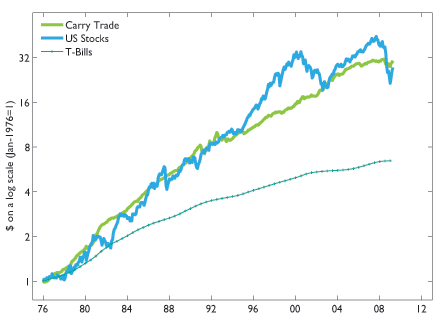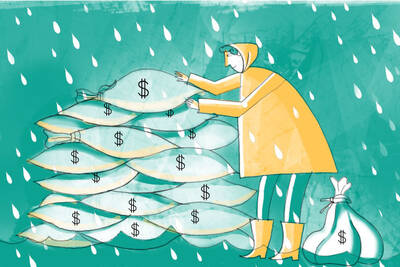Economic theory has been predicting the collapse of the carry trade for some time now, but the widespread currency-based strategy continues to pad balance sheets with profit. The carry trade works by borrowing money in low interest rate currencies and then lending it in high interest rate ones. Investors pocket the difference in interest rates as profit. Economic theory says the two exchange rates should adjust as more people exploit the interest rate differential, eliminating the profit potential. But this is not the case and the carry trade remains a successful staple for hedge funds and other investors. It sounds like a perfect strategy—almost too perfect. Behind the profits from the carry trade lurks a nagging question: Where does the money come from?
The carry trade is an enigma in the financial world. When experts attempt to explain its continued profitability using traditional risk factors such as consumption growth, stock market returns, and other more complex predictors, they fail miserably. The other possible explanation, “peso events,” has long been considered untestable. These rare and unexpected changes in the market, such as the sudden devaluation of a currency, can wipe out years of accumulated gains. Thus, higher interest rates in the lent currency may be the payoff for bearing the risk of a peso event. But determining the effect of an unlikely future event is something of an experimental nightmare.
Hoping to test for this, Sergio Rebelo (Tokai Bank Professor of International Finance at the Kellogg School of Management), Craig Burnside (Professor of Economics at Duke University), Martin Eichenbaum (Professor of Economics at Northwestern University), and Kellogg alumnus Isaac Kleshchelski (Assistant Professor of Finance at Washington University) collected monthly exchange rate data for twenty different currencies between January 1976 and January 2008. They assembled a variety of carry trade portfolios, each with the express purpose of probing the role of peso events. Many mathematical models later, they concluded these rare occurrences do indeed drive the strategy’s profit. Along the way, they also discovered a tantalizing new way to minimize the risk posed by the unpredictable.
Small Returns. Big Risk?
The carry trade is often described as “picking up pennies in front of a truck,” according to Rebelo. The strategy’s percentage of profit is very small. For example, say you borrow one U.S. dollar at the current interest rate of 0.25 percent. You then convert it into Australian dollars, where you lend the money at Australia’s current 3 percent interest rate. At the end of the year, you take the Australian dollars, convert them back into U.S. dollars, pay off your loan, and pocket the difference. Congratulations, you made 2.75 cents, not accounting for transaction costs. On this scale, the returns seem pitiful. But because you are using borrowed money, you could scale your borrowing up to billions of dollars without using any of your own money. At that point, a 2.75 percent return looks pretty good. The profits appear sound and ripe for the picking. And they would be, if not for the possibility of a peso event bearing down on you at any moment.
The term “peso event” and its cousin the “peso problem” originated in the 1970s. Mexico’s massive national debt, its continued inflation, and falling oil prices were sending its economy into a tailspin. The government was stubbornly keeping the value of the peso fixed to the U.S. dollar. Despite the peg, Mexican interest rates were higher than those in the United States. Economist Milton Friedman thought this was due to the market anticipating a devaluation of the peso. Yet to some, the higher interest rate spelled “free money” for those daring enough to borrow in dollars and lend in pesos. Investors reaped steady profits until markets opened on September 1, 1976, when the peso was allowed to float against the dollar. Its value plummeted more than 50 percent in one day, and many people suffered tremendous losses.
Predicting the daily ebbs and flows—or cliffs and crevasses—of the foreign exchange market is still fraught with uncertainty, something that vexes central bankers, investors, and academics. While traditional economic theory emphasizes the role of international trade in moving exchange rates, trade may only be sufficient to explain long-term trends. “On a weekly basis, on a monthly basis, it’s very difficult to find fundamentals that correlate with exchange rates,” Rebelo says. “In the short run, a lot of what goes on in exchange rate markets is driven by speculation.
“One thing central banks worry about is the carry trade,” he continues. Short-term speculation can give bankers headaches as they try to manage exchange rates. “They really want to understand why there is so much interest in the carry trade and how it affects high-frequency currency movements.”
Minimizing Risk without Minimizing Profit
Many believe speculation in the carry trade centers around the probability of a peso event, which many experts thought untestable. Rebelo and his colleagues presented a simple solution: use options. Options provide wary investors with a form of insurance, allowing them, for example, to hedge against the depreciation of their high interest rate currency. Options limit losses in peso events but they can quickly eat into profits in tranquil markets if peso events truly drive the speculation.
Rebelo and his colleagues tested the peso problem hypothesis by assembling a series of mock portfolios both with and without options. When they injected a peso event into a simulation, the unhedged portfolios lost much more money than the hedged positions. In calm conditions, the profit difference between the hedged (2.5 percent annually) and unhedged (3.2 percent annually) portfolios was large enough to confirm the peso problem hypothesis (see Figure 1). The insurance worked. The options, Rebelo says, had “put up some road blocks so the truck wouldn’t come.”

Figure 1. Although both versions of the carry trade produce positive payoffs on average, the hedged carry trade eliminates significant losses (note the truncated left tail in (b)).
But another mystery remained. The differences between the hedged and unhedged portfolios under normal conditions were strikingly small. The profits from hedging were lower, but not by much. Buying options merely skimmed off the top in good times and all but eliminated gut-wrenching losses during peso events. The hedged portfolios should not have performed nearly as well as they did. If the options had appropriately priced the risk associated with the peso problem, the cost of that insurance should have whittled away most of the carry trade’s meager margins. “Academics hate to admit market failures,” Rebelo concedes, but to the hedge fund managers he and his colleagues spoke with, the answer was clear: the options are too cheap.
Even without options, the carry trade has been historically profitable and stable on average. One dollar invested in the stock market in 1976 had made $27.39 by May 2009, while that same dollar in the carry trade produced $30.43 (see Figure 2). The carry trade’s risk also has been substantially lower when measured by the Sharpe ratio (0.904 vs. 0.358), an index that weighs a strategy’s profit against its risk. Even the recent financial crisis has been kinder to the carry trade. Since stocks peaked in October 2007, they have lost nearly 40 percent of their value. But the carry trade, which peaked in July 2008, is off by only 2.5 percent.

Figure 2. One dollar invested in 1976 in the carry trade (green line), the stock market (thick blue line), and Treasury bills. By May 2009 the investor in the carry trade has the most money ($30.43) compared to the other strategies ($27.39 for stocks and $6.47 for Treasury bills).
Despite the carry trade’s relative stability, investors are keenly interested in its mechanics. “People in the investment community, the investment practitioners, really care about it because they want to know—is this really picking up pennies in front of a truck?” Rebelo says. “Or is it a strategy that might work for a while?
“If it’s so good, why is it that people don’t do more of it?” he reflects. “That’s the big puzzle.”




